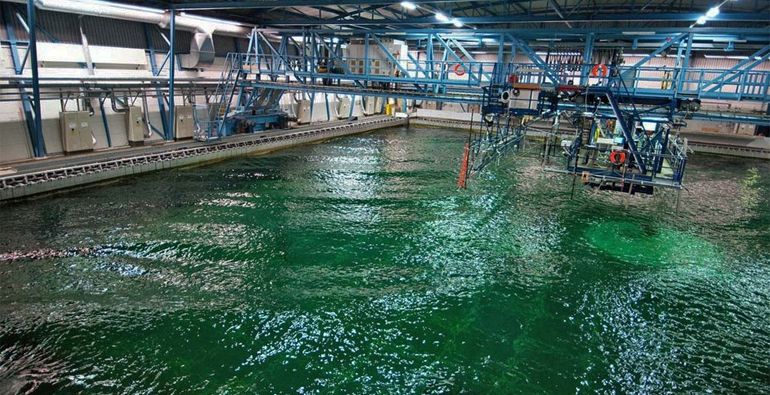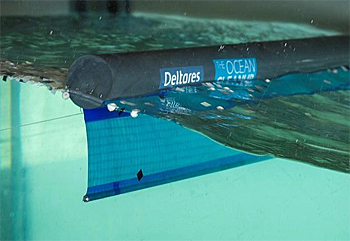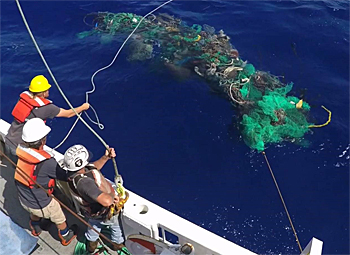Ocean Cleanup enters new stage with model experiments in test basins of Marin and Deltares, the Netherlands
 The Ocean Cleanup’s development of its cleanup technology has entered a new testing stage. Engineers installed a scale model of the plastic capturing array in an offshore basin at the Maritime Research Institute Netherlands (MARIN) in Wageningen, the Netherlands.
The Ocean Cleanup’s development of its cleanup technology has entered a new testing stage. Engineers installed a scale model of the plastic capturing array in an offshore basin at the Maritime Research Institute Netherlands (MARIN) in Wageningen, the Netherlands.
A few weeks earlier The Ocean Cleanup conducted a similar series of the scale model with its plastic collecting boom in a basin at the research institute Deltares in Delft, the Netherlands.
Flexible but still effective barrier
The challenge for The Ocean Cleanup is to design a long structure that can follow the waves and still collect the plastic from the ocean effectively.
At the basin of Marin in Wageningen, The Ocean Cleanup and its partner engineers will conduct dozens of tests on the behavior of the flexible barrier under varying current and wave conditions.
The hardware that has been placed in the water is 20 meters long, a 1:18 scale model of the 360-meter section of the array being tested.
 Earlier testing of the scale model at Deltares, the Netherlands.
Earlier testing of the scale model at Deltares, the Netherlands.
Unpredictable and powerful oceanic forces
Hydrodynamic engineer Mark Paalvast from Mocean Offshore says the tests at Marin will reveal the maximum operation limits of the array. "In other words, what are the toughest conditions under which the array can still do its job of concentrating plastic at a central collection point?"
Testing for this is no simple matter. The oceans are an environment with unpredictable, powerful forces that defy perfect simulation. Waves come from a variety of directions at once, and currents below the surface complicate matters even more.
"But the Marin offshore basin is one of the best facilities in the world to do these tests", says Paalvast. "It can send currents and waves from many different angles simultaneously, and at varying speeds. We will do lots of simulations and then use the data for additional computer modelling too."
 Large pieces of plastic collected in the Great Pacific Garbage Patch last summer.
Large pieces of plastic collected in the Great Pacific Garbage Patch last summer.
Accurate measurement of forces on boom
To assess the behaviour of the boom behaves water, The Ocean Cleanup collaborated with research institute Deltares in a series of scale model tests.
By generating artificial waves, currents and winds in a controlled environment, it was possible to accurately measure the forces that act on the boom and mooring lines.
Using the results of these tests, The Ocean Cleanup has been able to determine the hydrodynamic coefficients of the barrier, enabling the engineers to improve computer models of the overall cleanup system. The tests confirmed that The Ocean Cleanup’s full scale computer model shows a major resemblance to the outcomes of the Deltares tests.
Besides measuring forces, the Deltares testing program also set out to investigate the barrier’s ability to efficiently capture plastic under influence of waves, with promising results.
Successful measuring expedition in Pacific Ocean
The testing phase follows the Mega Expedition last summer when a fleet of 30 sail boats crossed the Pacific Ocean from Hawaii to San Francisco to collect plastic floating in the Great Pacific Garbage Patch.
A series of measurement techniques, including trawls and aerial surveys, were used to determine the real concentration of the floating plastic.
It was the largest ocean research expedition in history and for the first time large pieces of plastic, such as ghost nets and Japanese tsunami debris, have been quantified.
This news item was originally published on the website of The Ocean Cleanup.
Read also on this site
● Great pacific garbage cleanup fleet at full strength leaving Honolulu, Hawaii, 13 August 2015
● Ocean Cleanup announces world's first floatable ocean cleanup installation near Tsushima island, Japan, 29 May 2015
● Dutch inventor Boyan Slat wins UN top award for Ocean clean-up initiative, 18 November 2014
● Crowdfunding reached goal: 2 million dollars for prototype to clean oceans from plastics, 11 September 2014
More information
The Ocean Cleanup
Delft, the Netherlands
www.theoceancleanup.com
Explanation of the3D scale model tests at Marin, Wageningen.



